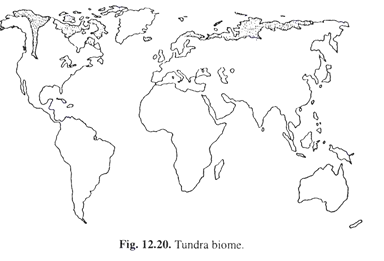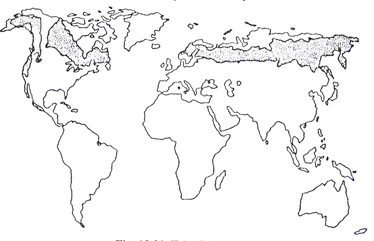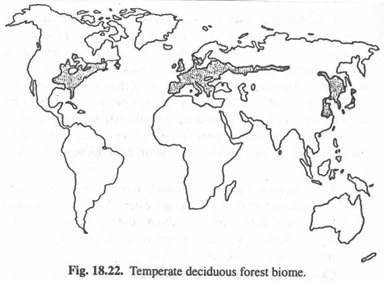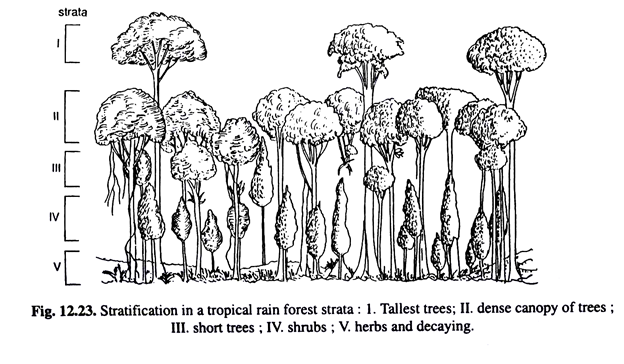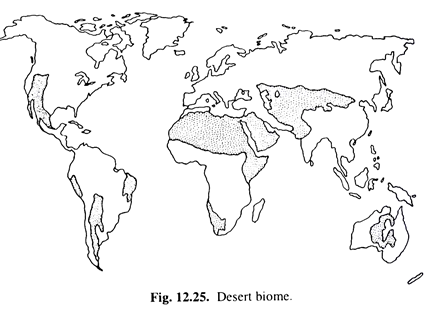The following points highlight the eight major biomes of the world. The biomes are: 1. Tundra 2. Northern Conifer Forest 3. Temperate Deciduous Forests 4. Tropical Rain Forest 5. Chapparal 6. Tropical Savannah 7. Grassland 8. Desert.
Biome # 1. Tundra:
The literal meaning of word Tundra is north of the timberline. The tundra extends above 60°N latitude. It is almost treeless plain in the far northern parts of Asia, Europe and North America. A tundra consists of plains characterised by snow, ice and frozen soil most of the year. The permanent frozen soil of tundra is called permafrost.
Winters are very long on the tundra with little daylight. In contrast summers are short but there are many daylight hours. Precipitation is low, amounting to only 25 cm or less per year, because cold air can hold relatively little moisture.
The ground is soggy in the summer because moisture cannot soak into the permanently frozen ground. Ponds, small lakes and marshes are abundant due to the nearly flat terrain.
There are no upright trees on the tundra. Only trees such as dwarf willows and birches, which grow low to the ground, can escape the drying effect of the wind which upright trees would experience. This biome consists mainly of mosses, grasses, sedges, lichens and some shrubs. Seasonal thawing of the frozen soil occurs only up-to a few centimetres depth, which permits the growth of shallow rooted plants.
Carbon, arctic hare and musk ox are important herbivores of tundra biome. Some important carnivores that prey on the herbivores are the arctic fox, arctic wolf, bobcat and snowy owl. Polar bears live along coastal areas, and prey on seals.
Because of the severe winters, many of the animals are migratory and move from one region to another with the change in seasons. Many shorebirds and water fowls, such as ducks and geese, nest on the tundra during the summer but migrate south for the winter. The tundra make a very delicate ecosystem, and may be recovered from any disturbance very slowly.
Biome # 2. Northern Conifer Forest:
The northern coniferous forest or taiga is a 1300-1450 km wide band south of the tundra. This extends as an east-west band across North America, Europe and Asia. This area also has long, cold winters, but summer temperatures may reach 10-12°C, and the summer and the growing season are longer than in the tundra. Precipitation is higher than in the tundra, ranging from 10 to 35 cm annually.
The moisture is the combined result of summer rains and winter snows. Lakes, ponds and bogs are abundant. The duration of growing period of plants is only about 150 days. Since five physical conditions are variable, the organisms are resistant to fluctuations of temperature.
The taiga makes really a northern forest of coniferous trees such as spruce, fir, pine, cedar and hemlock. In disturbed areas, deciduous trees such as birch, willow and poplar are abundant. In certain areas the trees are so dense that little light may reach the floor of the forest. Vines, maple and spring wild flowers are common. Mosses and ferns also grow in moist areas.
The common smaller mammals are herbivores, such as squirrels, snowshoe hare, and predatory martens. Important migratory herbivores include moose, elk, deer and carbon. Moose and carbon migrate to the taiga for winters and to the tundra for summers.
Important predators are the timber wolf, grizzly bear, black bear, bobcat and wolverine. Many insects are found during the warmer months. Migratory shore birds and waterfowls are abundant during summer months.
Biome # 3. Temperate Deciduous Forests:
The deciduous forests are found in the temperate regions of north central Europe, east Asia and the eastern United States, that is, south of the taiga in the Northern Hemisphere. Such forests occur in regions having hot summers, cold winter, rich soil and abundant rain. Annual rainfall is typically around 100 cm per year.
Common deciduous trees are the hardwoods such as beech, maple, oak, hickory and walnut. They are broad-leaved trees. The trees shed their leaves in the late fall so the biome has an entirely different appearance in the winter than in the summer.
The fallen leaves provide food for a large variety of consumer and decomposer populations, such as millipedes, snails and fungi living in or on the soil. The temperate deciduous forest produces flowers, fruits and seeds of many types which provide a variety of food for animals.
The common herbivores of this biome are deer, chipmunks, squirrels, rabbits and beavers. Tree-dwelling birds are abundant in number and diversity. Important predators are—black bears, bobcats, and foxes. Predatory birds are also found, such as hawks, owls and eagles. The coldblooded or ectothermic animals, such as snakes, lizards, frogs, and salamanders are also common.
The temperate deciduous forest makes a very complex biome. Many changes take place during the year, and a large variety of species inhabit the soil, trees and air.
Biome # 4. Tropical Rain Forest:
This biome is situated in the equatorial regions having the annual rainfall more than 140 cm. However, the tropical rain forest makes an important biome across the earth as a whole. This biome is found in Central America, the Amazon Basin, Orinocon Basin of South America, Central Africa, India and Southeast Asia.
Tropical rain forests have high rainfall, high temperature all year, and a great variety of vegetation. Plant life is highly diverse reaching up-to a framework of 200 species of trees per hectare. The warm, humid climate supports broad- leaved evergreen plants showing peculiar stratification into an upper storey and two or three understoreys.
The tallest trees make an open canopy, but the understoreyed plants block most of the light from the jungle floor. The climbers and lianas reach the highest level of the trees in search of light.
An enormous variety of animals lives in the rain forest, such as insects, lizards, snakes, monkeys and colorful birds. The ant eaters, bats, large carnivorous animals, and a variety of fish in the rivers are quite common. About 70-80 per cent of the known insects are found in tropical rain forests. Such rich animal diversity is linked to plant-animal interaction for pollination and dispersal of fruits and seeds.
Biome # 5. Chapparal:
This biome is also known as mediterranian scrub forest. This is marked by limited winter rain followed by drought in the rest of the year. The temperature is moderate under the influence of cool, moist air of the oceans. The biome extends along the mediterranian.
Pacific coast of North America, Chile, South Africa and South Australia. This biome has broad-leaved evergreen vegetation. The vegetation is generally made up of fire resistant resinous plants and drought-adapted animals. Bush fires are very common in this biome.
Biome # 6. Tropical Savannah:
The savannahs are warm climate plants characterized by coarse grass and scattered trees on the margins of tropics having seasonal rainfall. Primarily they are situated in South America, Africa and Australia. However, there is no savannah vegetation in India. The average total rainfall in such regions is 100 to 150 cm. There is alternation of wet and dry seasons.
Plants and animals are drought tolerant and do not have much diversity. The animal life of tropical savannah biome consists of hoofed herbivorous species, such as giraffe, zebra, elephant, rhinoceros and several kinds of antelope. Kangaroos are found in the savannahs of Australia.
Biome # 7. Grassland:
Some grasslands occur in temperate areas of the earth and some occur in tropical regions. Temperate grasslands usually possess deep, rich soil. They have hot summers cold winters and irregular rainfall. Often they are characterized by high winds. The main grasslands include the prairies of Canada and U.S.A., the pampas of South America, the steppes of Europe and Asia, and the veldts of Africa.
The dominant plant species comprise short and tall grasses. In tall-grasses prairies in the United States, important grasses are tall bluestem, Indian grass and slough grass. Short-grass prairies generally have blue grama grass, mesquite grass and bluegrass. Many grasses have long, well-developed root systems which enable them to survive limited rainfall and the effects of fire.
The main animals of this biome are-the prong-horned antelopes, bison, wild horse, jack rabbit, ground squirrel and prairie dogs. Larks, the burrowing owl and badgers are also found. Important grassland predators include coyotes, foxes, hawks and snakes.
Biome # 8. Desert:
The desert biome is characterised by its very low rainfall, which is usually 25 cm per year or less. Most of this limited moisture comes as short, hard showers. Primarily the deserts of the world are located in the south-west U.S.A., Mexico, Chile, Peru, North Africa (Sahara desert), Asia (Tibet Gobi Thar) and central Western Australia. Deserts generally have hot days and cold nights, and they often have high winds.
The reason for the difference of temperature between day and night is due to the lack of water vapour in the air. Deserts are characterised by scanty flora and fauna. Desert organisms must meet some initial requirements if they are to survive. The plants must be able to obtain and conserve water.
In order to meet these requirements, many adaptations have been made by desert plants. Such adaptations are—reduced leaf surface area, which reduces evaporation from the plants, loss of leaves during long dry spell; small hairs on the leaf surfaces, and the ability to store large amount of water.
The examples of important desert plants are—yuccas, acacias, euphorbias, cacti, many other succulents and hardy grasses. Many of the small plants are annuals.
Animals also must meet the requirements of heat, cold and limited water. Many desert animals are nocturnal in habit, and are active mainly at night. Many reptiles and small mammals burrow to get away from the intense heat of midday. The other common desert animals are the herbivorous kangaroo, rat, ground squirrel, and jack rabbit.
The important predators are—coyotes, badgers, kit fox, eagles, hawks, falcons and owls. Ants, locusts, wasps, scorpions, spiders, insect-eating birds, such as swifts and swallows, seed-eating quails, doves and various cats are other common desert animals.
